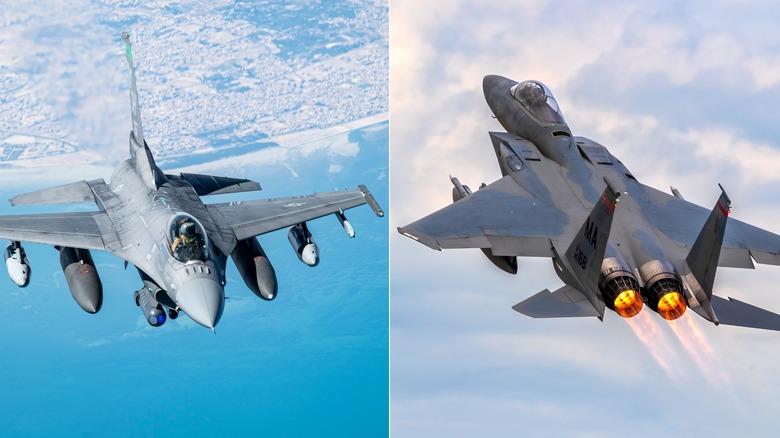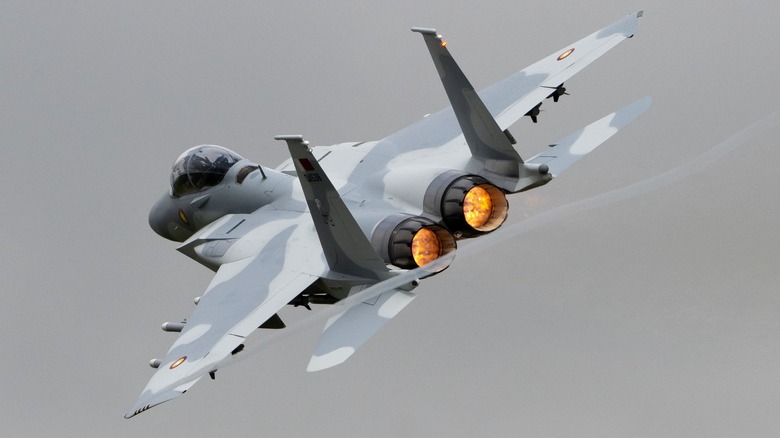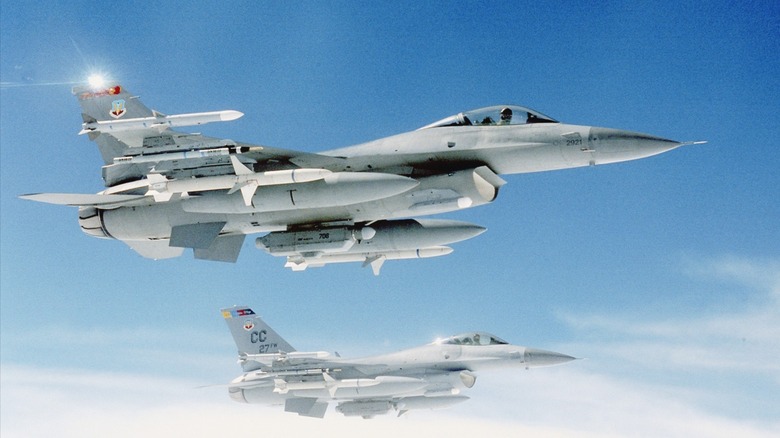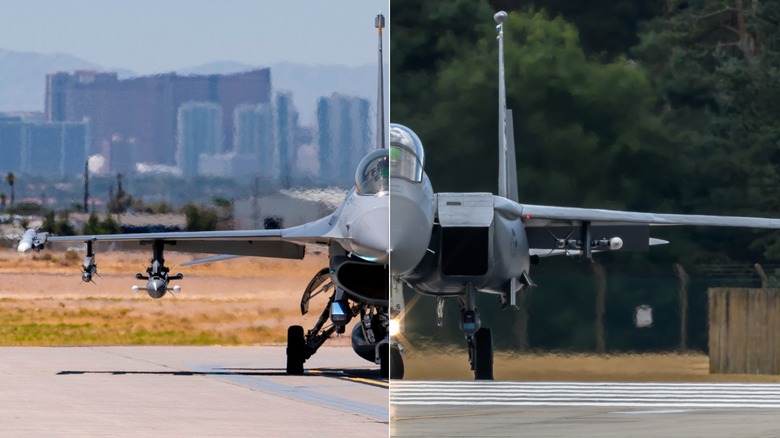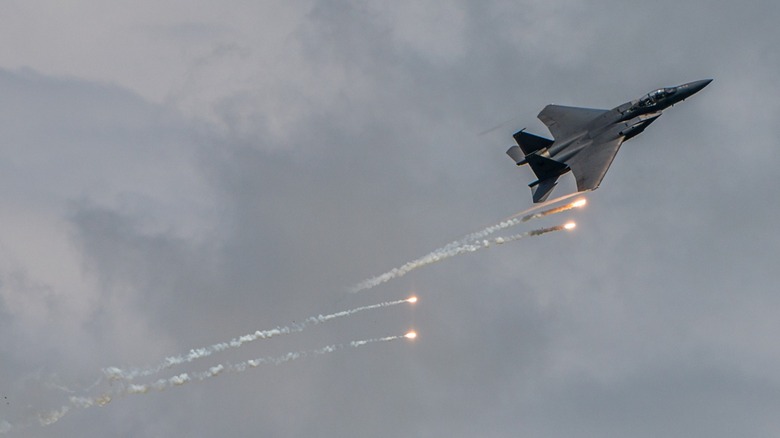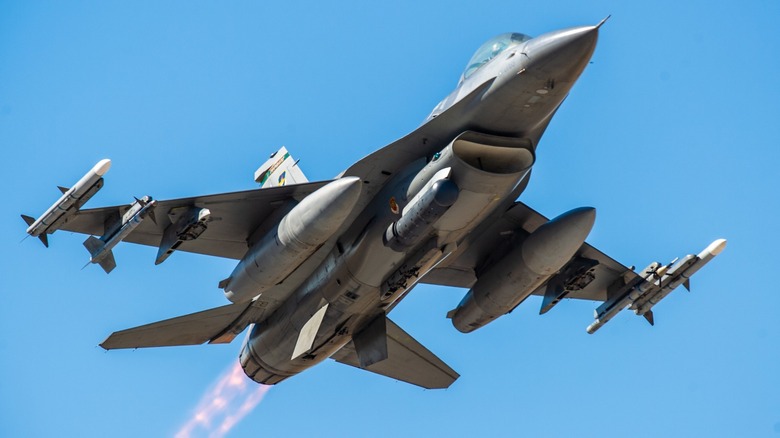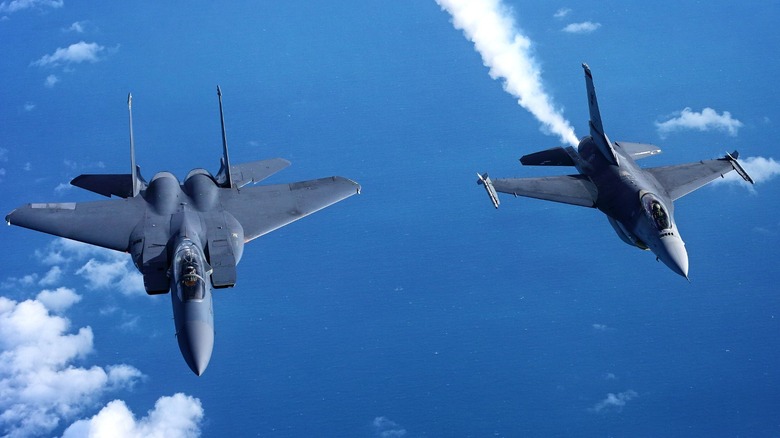F-15 Vs. F-16: What's The Difference Between These Two World-Renowned Fighter Jets?
Before the introduction of the F-22 Raptor and the F-35 Lightning II, the F-15 Eagle and the F-16 Fighting Falcon were the US Air Force's primary fighter jets. Both of these planes were a part of the high-low doctrine, where the former served as the complex and expensive high-end system while the latter was the simpler, more affordable 'low' fighter in America's fighter mix. Even as both aircraft models were launched in the 1970s, they're still highly effective platforms. The F-15 has proven itself to the point that the US has ordered a new and improved version, called the F-15EX Eagle II, as its new missile truck.
On the other hand, the F-16 Fighting Falcon is much more widely used today, with many countries aside from the U.S. having this innovative jet fighter in their inventories. Ukraine was also desperately asking for these jets to help its defense against the Russian invasion, which shows how much it considers the F-16 a crucial tool for its air force.
Given that both jets are popular and highly acclaimed, what's the actual difference between these two models? Let's look at both the F-15 Eagle and the F-16 Fighting Falcon and see what made these two jets different (and such a good complement for each other).
What is the F-15 Eagle?
The F-15 Eagle was first envisioned as an air superiority fighter in 1969 and began production in 1972 with McDonnell Douglas (now under Boeing). Delivery of the first F-15 began in 1974, but it was soon joined by the improved F-15C and F-15D in 1979. The F-15 airframe design was deemed to be so successful that the F-15E Strike Eagle was eventually developed. This version of the F-15 gave the fighter multirole capabilities, allowing it to participate in both air-to-air and air-to-ground sorties.
This development has allowed the USAF to use the F-15 for a variety of missions. These jets were used in enforcing no-fly zones during Operation Southern Watch in Southern Iraq, as well as for hunting SCUD missile launchers and artillery sites during the First Persian Gulf War.
But even though the F-15 design is already over 50 years old, the USAF has recently ordered its latest version — the F-15EX Eagle II. This upgrade would bring the jet to modern standards, giving it an updated flight control system. Aside from this, the Eagle II gets new GE engines, a new radar system, and even new color displays. The new jet also bumps up its armament capacity to 12 missiles, with the option to bring it up to 22 if the Air Force approves the proposed Advanced Missile and Bomb Ejection Rack (AMBER).
What is the F-16 Fighting Falcon?
The F-16 Fighting Falcon is a lightweight air-to-air fighter built for the USAF in the 1970s. It was first delivered in 1978 but is still in production today. In fact, Turkey, Bulgaria, and Slovakia currently have 70 new F-16s on order. Just like the F-15 Eagle, the F-16 eventually received air-to-ground attack capability, making it a truly versatile yet relatively affordable aircraft. At the moment, the USAF operates somewhere around 900 F-16s, making it the largest operator of the type. However, other countries like Turkey, Israel, Egypt, and Taiwan all operate over 200 each.
To save on development costs, the F-16 Fighting Falcon was designed by looking at existing platforms like the F-15 Eagle and F-111 Aardvark. Nevertheless, it's still a formidable weapon, where it was effectively used against opposing air forces during the 1982 Lebanon War and the first Persian Gulf War.
The F-16 is powered by a single jet engine — either a Pratt and Whitney F100-PW-200 series or a GE F11-GE-100 series engine. It has six hard points for various munitions and is also armed with a single 20mm cannon. Just like its bigger brother, it's also capable of air-to-air refueling and can also be equipped with conformal fuel tanks for longer combat range without reducing its performance.
How to differentiate the F-15 and the F-16
The easiest way to tell an F-15 from the F-16 is to look at their engines — the F-16 has a single engine, so it only has one exhaust nozzle at the back. It also has a single intake sitting right under the fuselage. On the other hand, the F-15 has two engines, so you will see two exhaust nozzles when you look at the back of the plane. It also has two intakes with a slanted rectangular opening sitting astride the fuselage, giving it a very distinctive look.
Another major difference between the two jets is that the F-16 has only a single vertical tail, while the F-15 has two. Because of the F-15's higher performance, the twin tail configuration is crucial for maintaining controllability. But that is not to say that the F-16 didn't perform as needed. This single-engine fighter only has one tail, as it doesn't need the extra flight control surfaces for its lesser top speed. Nevertheless, the plane is highly maneuverable, allowing it to hit up to 9 G's and outmaneuver the F-15.
What is the primary role of the F-15 Eagle?
The F-15 was primarily designed as an air superiority fighter when it first entered service. The USAF asked for this jet because it was terrified of the MiG-25 Foxbat, a supersonic interceptor that the Russians built to face the SR-71 and the proposed XB-70 Valkyrie supersonic bomber. Furthermore, while the F-4 Phantom IIs were advanced jets, they were more of an interceptor designed to fly fast and straight to take out large groups of bombers from a distance.
The U.S.'s experience in the Vietnam War showed that these large jets were at a disadvantage in the chaotic skies of contested air space, so it needed a plane that could close in on enemy fighters for visual identifications and then mix it up with the best of them. That's why the F-15A and F-15C were born as air superiority fighters, with the latter an improvement of the first version.
McDonnell Douglas (later Boeing) also made two-seater versions, the F-15B and F-15D, to help with training its pilots. The fighter pilot learning the ropes on the plane would sit up front while the instructor would sit at the back. In 1986, the F-15 added the strike fighter role to its repertoire after the introduction of the F-15E Strike Eagle. And when the Air Force retired the F-111 Aardvark, it was fully replaced by this variant of the F-15.
What is main mission of the F-16 Fighting Falcon?
General Dynamics (now owned by Lockheed) first built the F-16 Fighting Falcon as a more affordable air-to-air fighter for the USAF. The first variant to take flight for the Fighting Falcon was the F-16A, which was a single-seat air superiority version. It was followed by the two-seated F-16B, which is designed for training pilots on the type.
In 1981, the F-16 received provisions that allowed it to have multirole capabilities, turning the smaller jet from a purely air superiority fighter into a jet that can both defend the skies and support troops on the ground. These provisions led to the single-seat F-16C and two-seat F-16D variants.
While there were a few other variants of the F-16 introduced after the F-16D, the major, most modern variant available right now is the F-16V Block 70/72. These jets received conformal fuel tanks to extend the range of the fighter, as well as a tougher airframe that's rated at 12,000 hours — 4,000 more than the previous variant. Aside from those, it also received updated radar systems, targeting pods, digital displays, and an automatic ground collision avoidance system (Auto GCAS) to help pilots avoid control flight into terrain (CFIT) accidents.
The difference between the F-15 and F-16 fighters
After all that's been said and done, the F-15 and the F-16 have closely similar roles. They both started as air superiority fighters focused on speed and maneuverability, and they both eventually received multirole capabilities. However, the F-15 is often considered the more advanced and capable jet of the two and was the "higher" jet in the high-low mix at that time. On the other hand, the F-16 might have a little less performance versus the F-15, but its relatively low price and maintenance requirements make it a great bargain. That's probably one of the reasons why the jet remains popular today, even after nearly 50 years since its introduction.
Despite being old jets, the future of the F-15 and the F-16 still seems bright. Boeing is making the F-15EX Eagle II for the USAF, which, ironically, would now stand in as the "low" fighter in the high-low mix, with the F-35 Lightning II serving as the technologically advanced and superior fighter.
Lockheed is still also making the F-16, with the Block 70/72 variant being offered to countries that are looking for a cheaper fighter jet that could serve their needs. Aside from that, since many countries still operate the jet, there's still a healthy market for parts and services for the single-engine fighter.
